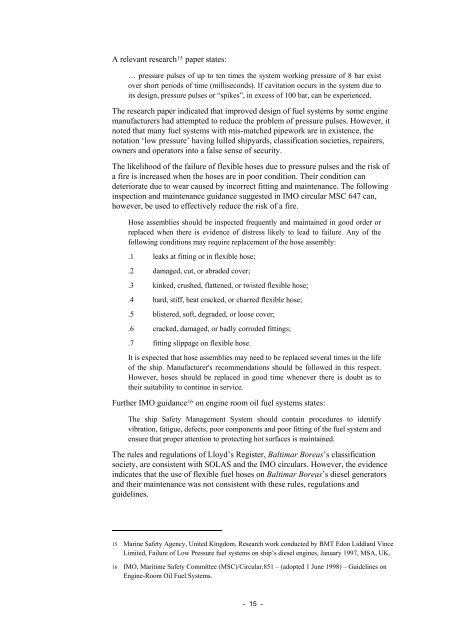Marine Report 236, Independent investigation into the engine room ...
Marine Report 236, Independent investigation into the engine room ...
Marine Report 236, Independent investigation into the engine room ...
Create successful ePaper yourself
Turn your PDF publications into a flip-book with our unique Google optimized e-Paper software.
A relevant research 15 paper states:<br />
… pressure pulses of up to ten times <strong>the</strong> system working pressure of 8 bar exist<br />
over short periods of time (milliseconds). If cavitation occurs in <strong>the</strong> system due to<br />
its design, pressure pulses or “spikes”, in excess of 100 bar, can be experienced.<br />
The research paper indicated that improved design of fuel systems by some <strong>engine</strong><br />
manufacturers had attempted to reduce <strong>the</strong> problem of pressure pulses. However, it<br />
noted that many fuel systems with mis-matched pipework are in existence, <strong>the</strong><br />
notation ‘low pressure’ having lulled shipyards, classification societies, repairers,<br />
owners and operators <strong>into</strong> a false sense of security.<br />
The likelihood of <strong>the</strong> failure of flexible hoses due to pressure pulses and <strong>the</strong> risk of<br />
a fire is increased when <strong>the</strong> hoses are in poor condition. Their condition can<br />
deteriorate due to wear caused by incorrect fitting and maintenance. The following<br />
inspection and maintenance guidance suggested in IMO circular MSC 647 can,<br />
however, be used to effectively reduce <strong>the</strong> risk of a fire.<br />
Hose assemblies should be inspected frequently and maintained in good order or<br />
replaced when <strong>the</strong>re is evidence of distress likely to lead to failure. Any of <strong>the</strong><br />
following conditions may require replacement of <strong>the</strong> hose assembly:<br />
.1 leaks at fitting or in flexible hose;<br />
.2 damaged, cut, or abraded cover;<br />
.3 kinked, crushed, flattened, or twisted flexible hose;<br />
.4 hard, stiff, heat cracked, or charred flexible hose;<br />
.5 blistered, soft, degraded, or loose cover;<br />
.6 cracked, damaged, or badly corroded fittings;<br />
.7 fitting slippage on flexible hose.<br />
It is expected that hose assemblies may need to be replaced several times in <strong>the</strong> life<br />
of <strong>the</strong> ship. Manufacturer's recommendations should be followed in this respect.<br />
However, hoses should be replaced in good time whenever <strong>the</strong>re is doubt as to<br />
<strong>the</strong>ir suitability to continue in service.<br />
Fur<strong>the</strong>r IMO guidance 16 on <strong>engine</strong> <strong>room</strong> oil fuel systems states:<br />
The ship Safety Management System should contain procedures to identify<br />
vibration, fatigue, defects, poor components and poor fitting of <strong>the</strong> fuel system and<br />
ensure that proper attention to protecting hot surfaces is maintained.<br />
The rules and regulations of Lloyd’s Register, Baltimar Boreas’s classification<br />
society, are consistent with SOLAS and <strong>the</strong> IMO circulars. However, <strong>the</strong> evidence<br />
indicates that <strong>the</strong> use of flexible fuel hoses on Baltimar Boreas’s diesel generators<br />
and <strong>the</strong>ir maintenance was not consistent with <strong>the</strong>se rules, regulations and<br />
guidelines.<br />
15 <strong>Marine</strong> Safety Agency, United Kingdom, Research work conducted by BMT Edon Liddiard Vince<br />
Limited, Failure of Low Pressure fuel systems on ship’s diesel <strong>engine</strong>s, January 1997, MSA, UK.<br />
16 IMO, Maritime Safety Committee (MSC)/Circular.851 – (adopted 1 June 1998) – Guidelines on<br />
Engine-Room Oil Fuel Systems.<br />
- 15 -
















